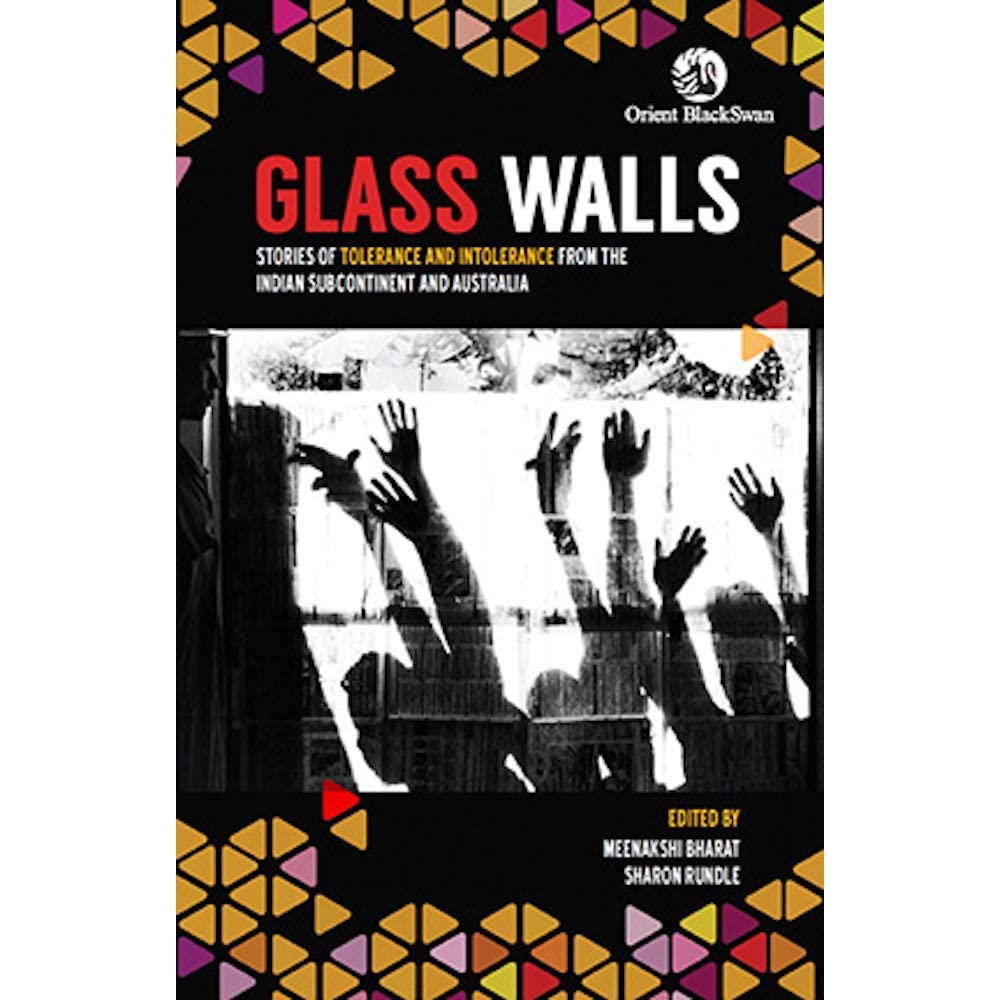Interview questions to the Glass Walls editors: Meenakshi Bharat and Sharon Rundle
by Suzanne Masri
What does the title Glass Walls truly mean and how does this resonate with the anthology?
Meenakshi: Glass Walls, a multivalent and multi-hued title arrived at after serious cogitation, resonates right across the whole gamut of stories on tolerance and intolerance from the Indian subcontinent and Australia. The glass walls could be intriguingly seen as simultaneously separating and allowing seeing the other side, thus representing both intolerance and tolerance, distancing yet bringing face-to-face. Further, separating glass walls need shattering as representations of intolerance but when allowing space for the ‘other’ across the walls, they become a celebration of difference and diversity.
Sharon: I would like to add to Meenakshi’s comments. Recently, in Australia, due to the coronavirus we have seen Perspex panels (or glass walls) between the staff and customers at supermarket check-outs. The elderly in aged care homes have a glass window (or wall) between them and their visitors. A physical manifestation of the metaphorical glass wall, in the form of protection. Whether we perceive the glass walls in our societies or not, they are there in all walks of life.
How did the idea for this anthology come about?
Meenakshi: Having successfully embraced and put into practice the idea of collecting creative responses to troubling issues of the day from different perspectives from the Indian subcontinent and Australia in three earlier volumes (Fear Factor: Terror Incognito, 2010; Alien Shores: Tales of Refugees and Asylum Seekers, 2012 and Only Connect: Technology and Us, 2014), we naturally moved to the wave of intolerance sweeping across the globe. We have managed to catch the pulse of the time with each anthology and no other theme seemed as pertinent and as tinder-hot as the ongoing narrow-minded bigotry, xenophobia and fanaticism.
Sharon: As Meenakshi has mentioned, this is the fourth anthology we have published, as such it contributes to our aim of opening up discussion to encourage deeper connections, and to create an awareness of cognitive dissonance that may underpin some of our biases. In fiction, readers are able to vicariously experience the lives of others. Stories reveal the narrator’s and characters’ thought processes to readers. Fiction is a two-way process between author and reader. As the late Elizabeth Jolley wrote: “Literary fiction leaves sophisticated gaps for intelligent readers.” Jolley’s story in Glass Walls is one of extreme tolerance, to the point of absurdity.
How were writers approached to contribute to the anthology? Did they need to apply to have their story published in Glass Walls; if so, were there criteria or specific themes writers needed to adhere to in their work?
Meenakshi: Contributor-interest has started becoming rife with each of our publications—in fact, already queries of when we are going to announce our next theme are pouring in. Glass Walls, volume four in the series, was the first time that we made a public call for contributions in an effort to get as diverse responses as we could. Nonetheless, we also partly fell back on our earlier modus of soliciting contributions form writers who we knew had something significant to say about the issue.
Sharon: As part of the aim of our Indo-Australian anthologies is to showcase Australian stories to India and stories from the Indian Subcontinent to Australia, we select a mix of stories from established (and notable) authors and from emerging authors. First and foremost, though, it is the stories that are selected rather than the authors. I would like to mention the generosity of our contributing authors to each anthology. Authors such as David Malouf, Debra Adelaide, Bruce Pascoe, Salman Rushdie, Neelum Saran Gour, Amitav Ghosh have all willingly supported us and allowed us to publish their stories.
How long was the compilation process and what were the challenges if any?
Meenakshi: The compilation itself took about a year. The challenges are self-evident: leaving out stories which were good in themselves, but could not be accommodated in the interest of thematic relevance, diversity of approach and balance. Though rejection is never easy, the easiest task was in culling out those that could have no place!
Sharon: Each anthology takes a minimum of two years to compile and publish. Usually longer. Reading through the stories is the most pleasurable task. The most challenging is often copyright. Many authors are not aware of the copyright status of work that has been previously published. Even established authors fall into this trap. As we follow copyright law to the letter, we need to thoroughly check the copyright status of any previously published stories. This can take many exchanges over a lengthy period. We are also involved in Permissions to publish the stories, then signing of formal publishing contracts and other legal obligations. We are continually liaising with authors and publisher. So we have a creative aspect and an administrative aspect, that we manage simultaneously.
What were the best moments during the compilation and publication process?
Meenakshi: The compilation of the collection brims with the opportunities of making ‘connections’ with new voices, new ideas. All the stories have been revelations! And overarching them all is the continuing rapport between us editors towards achieving our goal of as comprehensive coverage of the prickly theme as possible within the constraints of one volume.
It was a serendipitous meeting with the Vice President of the publishing house in the course of a conference in Chennai that brought us to Orient Blackswan. Their open minds, their dedication and their efficient yet concerned professionalism—of both the Commissioning the editorial teams—has made the publication process a delightfully productive and enjoyable one.
Sharon: The best moments: Notifying successful contributors that we are publishing their story; Seeing the parts come together as a whole and the book take shape; The book release and launches. Above all, the warm and generous support of all our contributors in Australia and on the Indian Subcontinent (and some who live in the USA) who have taken part in book readings, launches, podcasts, interviews and literary festivals to help promote the anthology. Truly, their support never ceases to amaze me.
What are your thoughts on the media and society’s confrontation of intolerances and is it possible that the written word has become the most effective platform for such concepts to be addressed?
Meenakshi: Sorry to say, media and society have been displaying more intolerance than confronting it. Glass Walls was specifically intended, in part, to begin the process of righting these wrongs and inadequacies. I believe creative writing provides the most confrontational platform for essaying considered response. In giving creative space to both tolerance and intolerance, as also our earlier issues, creative writing both posits and invites responses and makes space for thoughtful intervention.
Sharon: We are part of an interconnected and virtual world. Our previous anthology ‘Only Connect’ explored this theme. It is a unique time in our history. This has a positive effect and a negative effect on us, as people and as writers. The Internet and Social Media can be applied to increase our tolerance and understanding, it could be used to connect on a deeper level. Unfortunately, the dark web exists in the virtual world for those who pursue the darker side of humanity—the promotion of violence, incels, bullies, ridicule—but far more seriously, it allows for the dissemination of poorly sourced, inadequate or deliberately misleading information. The ‘pen’ or written word may well be mightier and more dangerous than the sword, yet the written word equally can be enlightening and as uplifting as a shaft of sunlight.
What would you advise aspiring writers?
Meenakshi: Believing that creative writing can make a tremendous difference, I think aspiring writers should be alert to take up the challenge of responding to the niggles assailing society and our contemporary world. Responsible artists can awaken a better world through their word. And each new writer has something new to say and a novel manner of saying it. Aspiring writers should make this space for themselves.
Sharon: Read, read, read – and then read some more! Be patient, patience is a writer’s best friend. When you have finished your first draft, cut it in half, then cut it again and again. Be a generous writer but a ruthless editor.
I would also advise aspiring writers to explore the craft of short story writing. It is an immensely satisfying form to write and to read. It requires condensing a story to its essence to illuminate a complex subject. Fiction reportedly connects with the sensory cortex, it can evoke memories and physical responses. A short story can be structured in myriad ways, such as realism, symbolism or a combination of these and more. The other useful advice is to know that each writer finds their own way of practising the craft. Again, patience is required.
This interview was conducted by a hardworking undergraduate student at Swinburne University.





